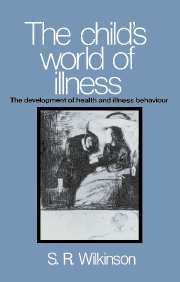Book contents
- Frontmatter
- Contents
- Acknowledgements
- Glossary
- 1 Presenting a problem
- 2 The form of dialogue
- 3 What has gone before: some background information
- 4 The primary structure to the child's world of illness
- 5 Germs and bugs: causal agents
- 6 Dirt and fresh air: the exogenous system
- 7 My castle and the good germs: the endogenous system and its boundary
- 8 ‘Pretend illness’: An analysis of how communication patterns can foster particular forms of complaints
- 9 The consultation: a form of dialogue
- 10 Health education and health promotion
- Appendixes
- References
- Index
7 - My castle and the good germs: the endogenous system and its boundary
Published online by Cambridge University Press: 23 September 2009
- Frontmatter
- Contents
- Acknowledgements
- Glossary
- 1 Presenting a problem
- 2 The form of dialogue
- 3 What has gone before: some background information
- 4 The primary structure to the child's world of illness
- 5 Germs and bugs: causal agents
- 6 Dirt and fresh air: the exogenous system
- 7 My castle and the good germs: the endogenous system and its boundary
- 8 ‘Pretend illness’: An analysis of how communication patterns can foster particular forms of complaints
- 9 The consultation: a form of dialogue
- 10 Health education and health promotion
- Appendixes
- References
- Index
Summary
In the descriptions so far I have looked at some of the microsystems within which the child develops his views on the causality of illness, the role of causal agents and how they might act within that system. I have presented how rules and a moral order are established which govern the child's relationship with his environment with regard to both health and illness. In this chapter I describe the individual's view of his contribution – the endogenous influences – which enable him to cope with the causal agents. This gives more insights into how children view the agents as acting and their bodies' resources for combating these. I suggest that the ways in which the children are socialised, with particular values becoming salient for them, foster to varying degrees their self-efficacy in maintaining their personal health. Lifestyles become established and to varying degrees under personal control.
The castle walls
Many of the younger children's comments suggested that they regarded their skin as an important boundary, protecting them from intruding environmental factors such as dirt and pollution as well as germs. The weak points are at the body's orifices such as the mouth and ears. Genitalia were not included by them in these discussions. The views persisted with the 13-year-olds, who thought for example that ‘[you get ill when you are] … sleeping with your throat uncovered when it's cold’. The same views are to be found amongst adults in England (Helman, 1978).
- Type
- Chapter
- Information
- The Child's World of IllnessThe Development of Health and Illness Behaviour, pp. 157 - 174Publisher: Cambridge University PressPrint publication year: 1988



